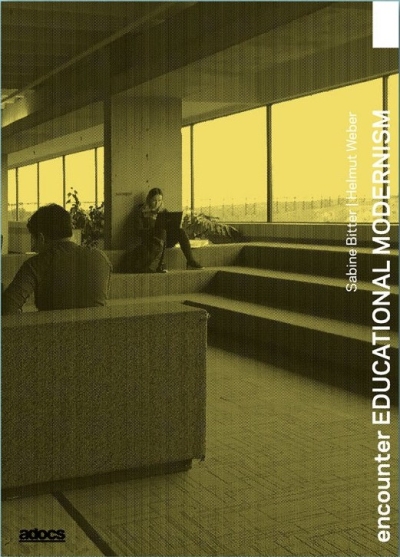gerade nicht auf Lager
Nick Couldry
The Space of the World. Can Human Solidarity Survive Social…
gerade nicht auf Lager
Mark Stoll
Profit. An Environmental History
Guillaume Paoli
Etwas Besseres als der Optimismus
Barragán Foundation
Barragán Outside Barragán
Leila Taylor
Sick Houses. Haunted Homes and the Architecture of Dread
Christina Köchling (Hg.)
Ästhetik der Technik. Drei Ökohäuser in den 1970-90er Jahre
gerade nicht auf Lager
Prof. Dr. Richard Woditsch (Hg.)
Chronologie einer Ideologie. Architektur-Biografien im…
Wenke Seemann
Wenke Seemann. Utopie auf Platte
Stefan Heidenreich
Attraktion und Mitmacht. Wie Kunst dem Kult des Exklusiven…
Cornelia Escher, Lars Fischer
Negotiating Ungers 3. Self Help Housing
gerade nicht auf Lager
Aylin Akyildiz, Karoline Fahl, Steffen…
Einrichten in der Normalität – Wie Kinder und Jugendliche…
Henning Lundkvist
Columns
gerade nicht auf Lager
Sabine Bitter, Helmut Weber
Encounter EDUCATIONAL MODERNISM
Joseph Vogl
Meteor. Versuch über das Schwebende
gerade nicht auf Lager
Sezgin Boynik, Tom Holert
Engström/Farocki: About Narration (1975). Materials,…
gerade nicht auf Lager
Derek Jarman
Derek Jarman. A Finger in the Fishes Mouth
gerade nicht auf Lager
Jean-Pierre Chupin
Analogical Thinking in Architecture. Connecting Design and…
gerade nicht auf Lager
Scott Colman
Ludwig Hilberseimer. Reanimating Architecture and the City
gerade nicht auf Lager
Ammar Azzouz
Domicide. Architecture, War and the Destruction of Home in…
gerade nicht auf Lager
Marko Jobst, Naomi Stead (eds.)
Queering Architecture. Methods, Practices, Spaces,…
Marina Tabassum
Khudi Bari. A social project by Marina Tabassum Architects…
IDEA Magazine
IDEA 408. Pixels Speak: Worlds of Tiny Dots and Design…
IDEA Magazine
IDEA 407. Towards a Future Bound to Print Media: Those Who…
IDEA Magazine
IDEA 406. Ikki Kobayashi - Life through Design Drawings
IDEA Magazine
IDEA 405. Sneaking a Look. Cross Sections, Floor Plans…
Ludwig Heimbach (Hg.)
Mäusebunker und Hygieneinstitut. Eine Berliner…
gerade nicht auf Lager
Pascal Gielen
Trust. Building on the Cultural Commons
Irene Revell, Sarah Shin (eds.)
Bodies of Sound. Becoming a Feminist Ear
Ilaria Marotta, Andrea Baccin &…
The Uncanny House
gerade nicht auf Lager
Enzo Traverso
Gaza Faces History
gerade nicht auf Lager
Irene V. Small
The Organic Line
gerade nicht auf Lager
Sandra Schäfer
Contested Landscapes
Nina Franz
Militärische Bildtechniken. Von der frühen Neuzeit bis ins…
Volker Pantenburg
Einfachheit ohne Vereinfachung. Zur Praxis Harun Farockis
gerade nicht auf Lager
Justin Barton, Steve Goodman, Maya B.…
Sonic Faction. Audio Essay as Medium and Method
Lucas Ferraço Nassif
Unconscious/Television
gerade nicht auf Lager
Terry Farrell, Adam Nathaniel Furman
Postmodernism. Architecture That Changed Our World
Natasha Aruri, Katleen De Flander,…
Critical Mapping for Municipalist Mobilization. Housing…
gerade nicht auf Lager
Nida Abdullah, Chris Lee, Xinyi Li (…
Through Witnessing. Threading the critiquing, making,…
gerade nicht auf Lager
Cecilia Casabona, Ginevra Petrozzi (Eds…
Death Design Data
gerade nicht auf Lager
Miriam Rasch, Jojanneke Gijsen, Harma…
hands on research for artists, designers & educators
gerade nicht auf Lager
Rosi Braidotti
Posthuman Knowledge and the Critical Posthumanities
gerade nicht auf Lager
Anna Colin
Alternative Pedagogical Spaces: From Utopia to…
gerade nicht auf Lager
Annett Jahn, Ulrike Mönnig (Hg.)
An den Rändern taumelt das Glück. Die späte DDR in der…
gerade nicht auf Lager
Silvia Franceschini, Nikolaus Hirsch,…
Pre-Architectures
gerade nicht auf Lager
David Toop
Two-Headed Doctor. Listening For Ghosts in Dr. John's…
gerade nicht auf Lager
Thordis Arrhenius, Ellen Braae, Guttorm…
Architecture and Welfare. Scandinavian Perspectives
NIcole Schweitzer (Hg.)
Uriel Orlow. Forest Times
Michael Schäfer
Invasive Links
Daniel Berndt, Susanne Huber, Christian…
ambivalent work*s. queer perspectives and art history
gerade nicht auf Lager
Jorge Silvetti, Hg. von Nicolás Delgado…
Large, Lasting and Inevitable. Jorge Silvetti in Dialogues…
gerade nicht auf Lager
Giulio Bettini, Daniel Penzis
Typostruktur. Sehnsucht nach architektonischer Relevanz
gerade nicht auf Lager
Laura U. Marks
The Fold. From Your Body to the Cosmos
gerade nicht auf Lager
Emmanuele de Donno
Construction of the Universe - Artists' Magazines and…
gerade nicht auf Lager
Julia Grosse, Jenny Schlenzka
Rirkrit Tiravanija: On Making Less
gerade nicht auf Lager
Harry Vogt, Martina Seeber (Hg.)
Radio Cologne Sound. Das Studio für Elektronische Musik des…
Marion Hirte, Daniel Ott, Manos…
Schnee von morgen. Statements zum Musiktheater der Zukunft
Claire Bishop
Merce Cunningham's Events: Key Concepts
gerade nicht auf Lager
Viyaleta Zhurava
FIGUREN / SHAPES
dérive
dérive N° 98, Eigentum (Jan-Mar 2025)
Viktoria Schabert
Eileen Gray's Museum
Arch+ Zeitschrift für Architektur und…
Arch+ 258. Urbane Praxis
Oxana Gourinovitch
Raising the Curtain. Operatic Modernism and the Soviet…
gerade nicht auf Lager
Lydia Kallipoliti
Histories of Ecological Design. An Unfinished Cyclopedia
Anders Engberg-Pedersen
Martialische Ästhetik
gerade nicht auf Lager
Matthias Ballestrem, Katharina Benjamin…
Constructive Disobedience
gerade nicht auf Lager
Sofie De Caigny, Hülya Ertas, Bie…
As Found. Experiments in Preservation
!Mediengruppe Bitnik, Janez Fakin Janša
(un)real data ☁️ – (🧊)real effects
gerade nicht auf Lager
Docomomo International (Ed)
Modernism in Africa
gerade nicht auf Lager
Daniela Hamaui (Ed.)
Archivio Magazine N°10. The Design Issue
gerade nicht auf Lager
Derk Loorbach, Véronique Patteeuw, Léa-…
It's About Time. The Architecture of Climate Change
gerade nicht auf Lager
Noemi Biasetton
Superstorm
gerade nicht auf Lager
Steven Henry Madoff
Why I Do What I Do - Global Curators Speak
Leopoldina Fortunati, Carla Lonzi
Folio G: Gendered Labour and Clitoridean Revolt
Carlos Moreno
Die 15-Minuten-Stadt. Ein Konzept für lebenswerte Städte
Julian Rose
Building Culture
gerade nicht auf Lager
Charlotte Malterre-Barthes (Ed.)
On Architecture and the Greenfield
Ulrike Brückner, Bianca Herlo
Design als Haltung. Handlungsfelder jenseits des…
Folke Köbberling
WOLLBAU. Wolle - Eine unterschätzte Ressource.
Melanie Franke (Hg.)
Selbsterzählungen und Umbruchspuren im Œuvre von Künstler:…
gerade nicht auf Lager
Stellan Gulde (Ed.)
Banal Buildings. Anthology
gerade nicht auf Lager
Franz Liebl
Steakholder Management. Bausteine eines Culinary Turn in…
Urszula Kozminska, Nacho Ruiz Allen
Time Matters
Anja Kaiser, Rebecca Stephany
Glossary of Undisciplined Design
gerade nicht auf Lager
Ursula K. Le Guin
Steering the Craft. A Twenty-First-Century Guide to Sailing…
Helmut Draxler
Was tun? Was lassen? Politik als symbolische Form
Enzo Traverso
Gaza im Auge der Geschichte
gerade nicht auf Lager
Gene Ray
After the Holocene. Planetary Politics for Commoners
Paolo Cirio
Climate Tribunal. Fossil Fuels Industry on Trial
சிந்துஜன் வரதராஜா (Sinthujan…
Hierarchien der Solidarität. Hierarchies of Solidarity.
gerade nicht auf Lager
Simon O'Sullivan
From Magic and Myth-Work to Care and Repair
gerade nicht auf Lager
André Tavares
Architecture Follows Fish. An Amphibious History of the…
Daniela Comani
You Are Mine
Friedrich von Borries
Architektur im Anthropozän. Eine spekulative Archäologie
Lisa Luksch, Andres Lepik (ed.)
Reading Visual Investigations. Between Advocacy, Journalism…
gerade nicht auf Lager
Jeppe Ugelvig (Ed.)
Viscose Journal 07. Scent
George MacBeth
e-flux Index #3
gerade nicht auf Lager
Kateryna Malaia, Philipp Meuser
Mass Housing in Ukraine. Building Typologies and Catalogue…


































































































